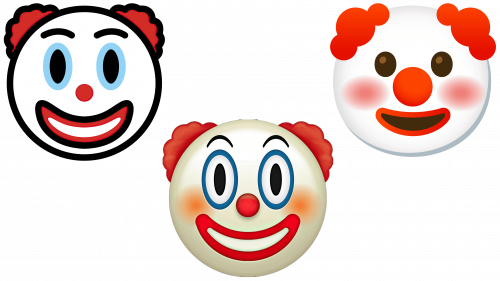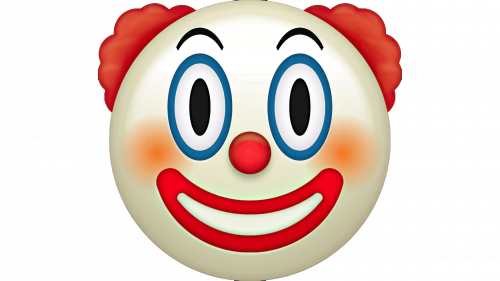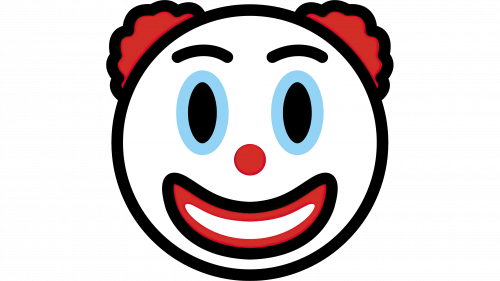The Clown emoji 🤡 stands as a digital rendition of a classic circus clown. It showcases a face with a pale complexion, highlighted by stage makeup that includes a vivid red nose, an exaggerated mouth, and strikingly large eyes, often surrounded by circles to enhance the effect. Depending on the digital platform, the hair flanking the noticeable bald area may appear in varying hues.
First introduced to the Unicode Standard in version 9.0 in 2016, this emoji quickly became an integral part of digital communication across various platforms. That same year, it was also added to Emoji 3.0. A notable feature of the Clown emoji is its universal design, which eschews specific gender or skin tone variations, thereby preserving its quintessential clown appearance on different devices and social media platforms.
Meaning and use of the Clown Face emoji
The Clown Face emoji, once synonymous with the vibrant and merry atmosphere of circuses, has seen a shift in its digital portrayal. Initially, it captured the essence of clown characters seen in carnivals and festive events, symbolizing merriment and laughter. Over time, the use and interpretation of this emoji have broadened.
In modern digital communication, the Clown Face emoji often takes on a different shade of meaning. It’s frequently employed to suggest foolishness or to lightly rib someone for making a poor joke. This emoji has become a tool for light-hearted chiding, particularly regarding someone’s nonsensical or unsuitable behavior.
Beyond this, the Clown emoji has acquired a more ominous role for some. It can conjure up images from the horror genre, especially reminiscent of the daunting clown character in Stephen King’s acclaimed novel “It.” This linkage infuses the emoji with an eerie quality, starkly contrasting its initial, innocuous representation.
The circus clown emoji, marked by its white makeup and striking red nose, offers a range of meanings beyond its initial appearance. Traditionally linked to the jovial and trickster nature of the Joker, this emoji has diversified in the realm of digital expression. It adeptly represents both amusing and eerie situations, showcasing its adaptability in online conversations.
The clown emoji has taken on newer roles in the evolving landscape of social media and digital chats. It’s frequently used to imply foolishness or to playfully point out someone’s nonsensical behavior, moving away from its original connotation of pure fun. Moreover, on platforms like TikTok, the clown face emoji has transcended its conventional usage. It has become a digital meme in its own right, capturing a spectrum of emotions and responses and connecting with a broad audience in the online community. This evolution reflects the dynamic nature of digital communication, where symbols take on new life and meanings based on popular culture and user interactions.
The “clown face” emoji in TikTok
The Clown Face emoji has carved a unique niche on the TikTok platform, becoming a staple in video descriptions and comments. Its cultural impact is substantial, with over 70 million views under the #clown hashtag. On TikTok, the emoji serves functions that diverge from its traditional uses.
In the TikTok universe, the 🤡 Clown Face emoji is multifaceted:
- Primarily, it’s used for playful ribbing, adding a touch of humor to interactions by gently poking fun at someone or something.
- Interestingly, it’s also a digital representation of schadenfreude, capturing the guilty pleasure people sometimes feel in response to others’ misfortunes.
- Moreover, it aligns with its roots by marking content that features actual clown characters or themes, staying true to its original circus clown imagery.
The way the Clown Face emoji is utilized on TikTok highlights its dynamic nature in the world of online communication. It has evolved beyond a simple graphic symbol, mirroring the platform’s varied and creative user base. This adaptability showcases how digital symbols can grow and change, taking on new meanings in different contexts.
Final thoughts
In the realm of digital messaging, the clown face emoji has emerged as a versatile character. Its ability to adapt to various scenarios allows it to encapsulate a spectrum of emotions and attitudes. This emoji can be playful and light-hearted, signaling enjoyment and fun, or it can take a turn towards sarcastic and mocking, adeptly used to tease or convey irony.
The 🤡 clown face emoji has even expanded its reach into the realm of horror, reminiscent of spooky clowns from popular movies. In a more contemporary twist, it’s occasionally employed to represent well-known public figures, such as Donald Trump, in a humorous but critical manner.
Commonly, the clown face emoji is used for:
- Playful teasing or sarcasm, often injected with humor.
- Highlighting moments of joy and entertainment.
- Conveying irony, where the outward message is undercut by an implied, different meaning.
- Self-deprecating humor, showcasing an ability to make fun of oneself.
- Offering a sarcastic take on ideas or comments, blending humor with critique.
This emoji’s broad range of applications demonstrates its value in modern digital communication. It provides a concise way for users to express a wide array of emotions and thoughts, from amusement to critique, illustrating the dynamic nature of digital interaction.






